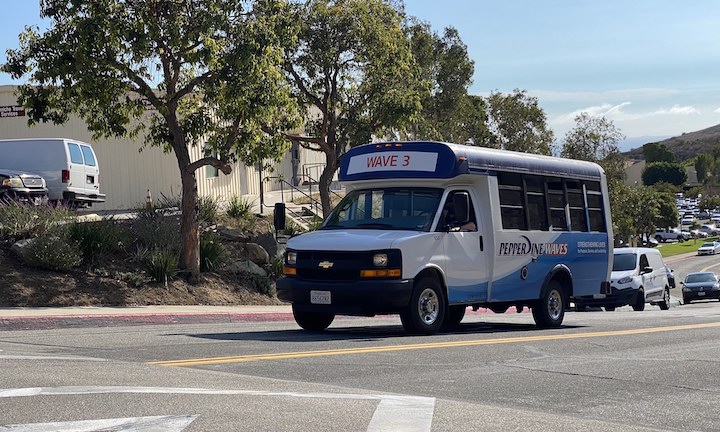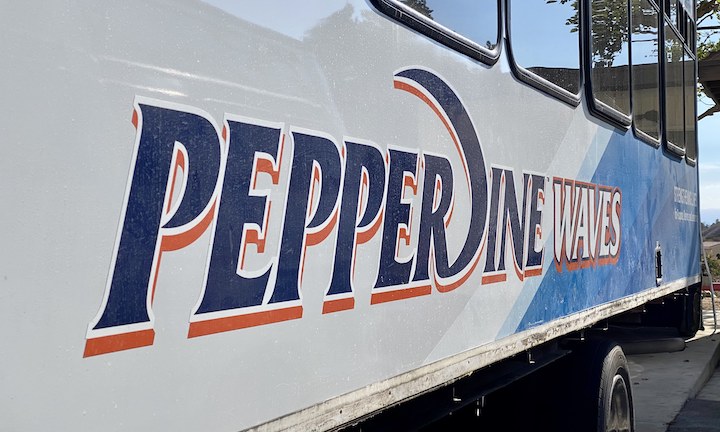
A welcoming driver, a reliable bus and an ease of mobility for everyone.
These are the hallmarks of Pepperdine’s Transit Service.
The 10-member team of Pepperdine’s Transit Services Department works tirelessly to keep the community moving. They range from the maintenance team who work to keep the shuttles in tip-top shape to seven friendly drivers with whom the student body interacts with every single day.
“The heart of our mission is to connect with the students,” Transit Services Manager Sean Kavanagh said. “Get to know them, encourage them and we just do that through transportation.”
Building and supporting the strong sense of community at Pepperdine is essential to the people of Transit Services. That is why in 2019, they replaced the title of shuttle driver with the title of transit ambassador.
“We felt the term ambassador, somebody that is known for goodwill and service to others, would be an appropriate title,” Campus Operations Director Dennis Melendez.

The relationship between transit ambassadors and the student body
Pepperdine’s transit ambassadors hold a critical role in the day-to-day life of the university. Without them the school would, quite literally, grind to a halt.
From Aug. 20 to Oct. 20, the shuttles on the Orange and Blue routes had a combined ridership number of 58,435. On an average weekday, each shuttle travels over 125 miles. Shuttles go in for a large inspection every 3,000 miles.
Ivan Manriquez, a sophomore political science major, lives in Drescher Campus and rides the shuttle up to three times a day.
“Without them (the shuttles) this big school would just be a big school,” Manriquez said. “We wouldn’t be able to travel around campus.”
Kavanagh said it is a job that brings joy to everyone who sits in the driver’s seat.
“I started working for Transit Services about eight years ago,” Kavanagh said. “I was hired on as a driver and just fell in love with it.”
Daily interactions with students mean a lot to transit ambassadors.
“We’re such a diverse community,” Kavanagh said. “It’s just so special to be able to tap into that and get to know the students, faculty and guests. It’s just such a great, unique experience.”
Camila Bonavia, assistant vice president of Administration and Campus Operations, said the relationship between the students and the transit ambassadors means a great deal to her.
“It is a touchstone of Pepperdine,” Bonavia said. “It is really important to the university that we have people in those roles that find the same value that our students find in them.”
This bond is one that resonates with students long after their time at Pepperdine.
“We have students who will have invited shuttle drivers to their weddings down the line,” Bonavia said. “Because that’s how special their relationship was.”
Alicia Yu, a senior business administration major, appreciates the transit ambassadors’ service to the Pepperdine community.
“They are the true MVPs of this campus,” Yu said.

How Pepperdine’s administration gave Transit Services a lift during the COVID-19 pandemic
Transit Services did not furlough a single employee during the COVID-19 pandemic.
“The university was still committed to keeping us employed,” Kavanagh said. “Which was an incredible blessing and shows the heart of our senior leadership that they value the people.”
With the majority of students not on campus, Transit Services ambassadors had to adapt. Instead of running a timetable schedule, the university adopted a program called Dial-a-Wave, where a student would call DPS, who would then dispatch a shuttle to the student’s location.
“It was basically the cafeteria,” Kavanagh said. “They weren’t going to many places.”
Transit ambassadors who weren’t actively working for shuttle operations went to other areas around campus. They went to help in Mail Services, Print Services and Warehouse Services. Some even assisted Facilities Services by helping to run the water in the dormant buildings.
“Keeping our employees employed was just a top priority,” Bonavia said. “They (the administration) were able to kind of juggle different priorities and move stuff around financially such that we did not have to furlough any of our employees, which was a miracle.”
Pepperdine faces roadblocks while hiring new transit ambassadors
There are currently two vacant positions open for drivers with a third position set to open in the near future because of someone transferring to another area of the university.
The university has been actively recruiting people to fill these positions long-term.
“We’ve been using Indeed as a search engine for candidates,” Melendez said.
However, the university has faced two significant challenges in finding candidates to fill these roles: A national hiring shortage and Pepperdine’s secluded location.
The national hiring shortage has hit the bus driving industry particularly hard, Jennifer Calfas wrote in a September 2021 Wall Street Journal article. Authorities had to call in members of the National Guard in Massachusetts in order to drive school vans so school drivers were free to drive the larger busses.
Pepperdine’s secluded, although scenic, location has proved to be a problem when recruiting new members to Transit Services.
“I can’t really go past 25 miles,” Melendez said. “Even then, there are some that pop up in Camarillo and Thousand Oaks that still would prefer not to make this commute.”
The number of candidates declining to take positions at Pepperdine due to the commute is a recent phenomenon.
“A big contributor to that is the high cost of gas right now,” Bonavia said. “Paying a certain amount of money if you live really far away just to get to your job is challenging for a lot of people.”
Transit ambassadors make $17-$21 per hour, which is above Pepperdine’s wage floor of $16.82 per hour, Bonavia said.
To fill the current void in the team, the university has hired two drivers from a temp agency.
Their current contract ends Dec. 12 for winter break.
Looking down the road to new shuttles
The university has also been exploring options for replacing some vehicles in the current Transit Services fleet, including electric shuttles, but there are currently some limitations to these new electric vehicles.
“Unfortunately, our hills are too much of a challenge for the technology that is available right now,” Bonavia said.
The steep grades which the shuttles wrestle with each day put incredible strain on the vehicle’s drivetrains and braking systems.
“Even our carts have trouble navigating these hills,” Melendez said.
The university’s auto shop employees would also need to be retrained and recertified in order to work on electric vehicles.
“There are three mechanics that work for campus operations in the auto shop,” Melendez said. “And that would be a very transformative change for them to go from gasoline-powered to electric.”
These obstacles are not dead ends but speed bumps in Transit Services’ desire to improve its fleet.
“We aren’t resting on our laurels. We definitely want to have a cleaner fleet not just for transit services, but for all of our university fleet vehicles,” Bonavia said. “Once the technology is up to par.”
Zach Jones completed the reporting for this story in Jour 241 in Fall 2021 under the supervision of Dr. Christina Littlefield and Dr. Theresa de los Santos. Dr. Littlefield supervised the web version of the story.

